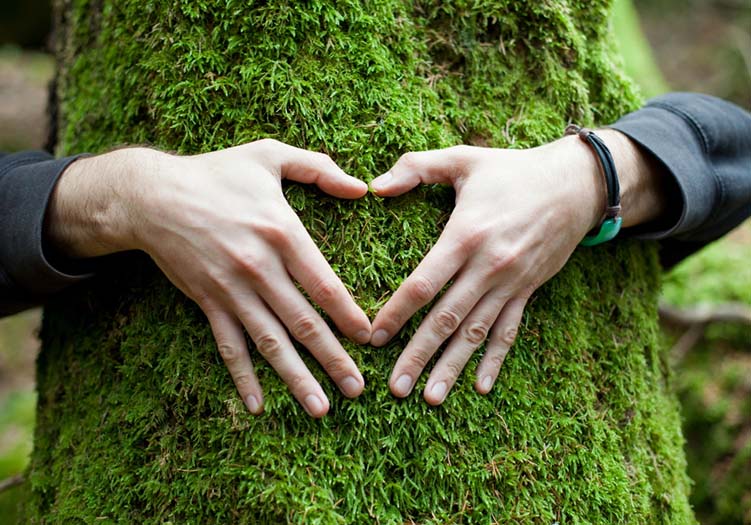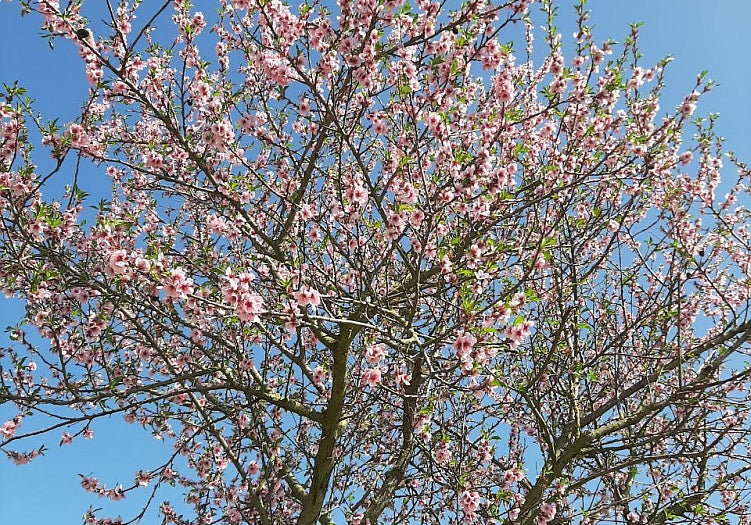Your shopping cart is currently empty.
| Subtotal | €0,00 |
| Shipping Rate | including VAT, excl. Shipping Rate |
| Total | €0,00 |
|---|
Frequently asked questions about the baumbad irrigation bag
Our customers ask
Further down are hearts with country flags. If you click on this you will go directly to the FAQ page with videos in the respective national language.
FAQ videos in INT (English)
FAQ Videos in IT (Italian)
FAQ videos in FR (French)
FAQ Videos in ES (Spanish)
FAQ videos in NL (Dutch)
FAQ Videos in PT (Portuguese)
FAQ videos in DK (Danish)
FAQ videos on EN / USA (with unit of measurement gallons)
You can find the instructions for the baumbad watering bags in the section
“Tree knowledge” > “Instructions for watering bags”
But if you do now
Once you're here, you can also get the instructions directly here access online here
or simply download:
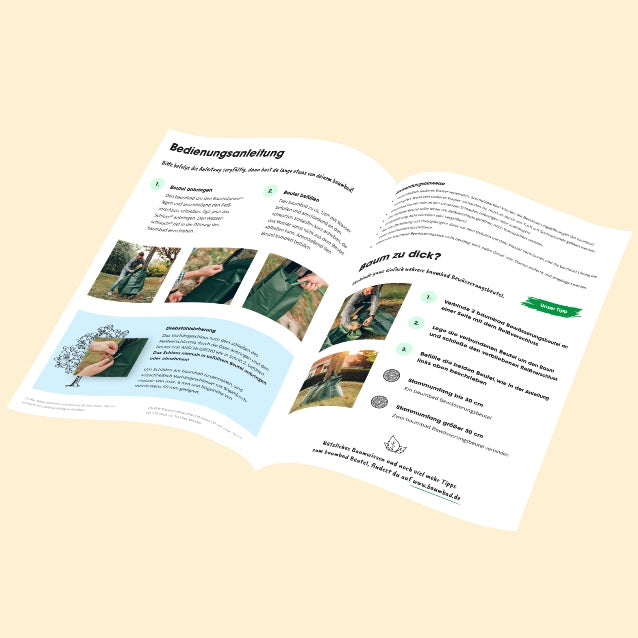
To fill the baumbad watering bag, please carry out the following steps:
1. Place the watering bag around the tree trunk and then close the zipper. (Note: one bag will comfortably cover up to 30 cm of tree circumference. For larger trees, it is recommended to use two or more bags.)
2. Push the water hose (max. 10 cm diameter) deep into the opening of the irrigation bag (alternatively: “insert”).
3. First fill the irrigation bag only about 1/6 (depending on the bag volume between 10 L and 18 L) with water, and then lift the bag using the black loops (shake it up). This is important to ensure the bag is in an upright position, otherwise the water may not drain properly from the bag.
4. Then fill the bag completely.


A tree watering bag is the ideal watering aid for trees. The bag is placed around the trunk like a jacket, zipped shut and then filled with water. The water escapes slowly and drop by drop through two small openings on the bottom of the bag, ensuring a long-lasting watering process. This saves you water, time, money and becomes a #tree saver.
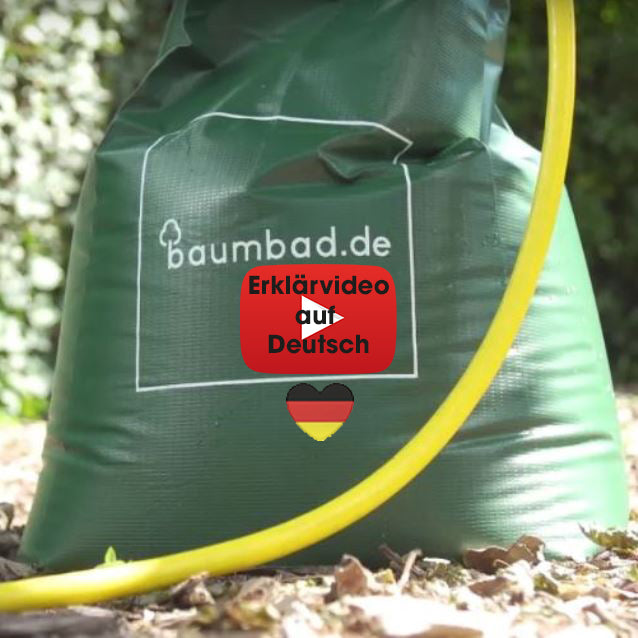

The tree watering bags are designed in such a way that the water drips out very slowly from two openings at the bottom folds. The openings are on the left and right of the bag. If the bag is shaken and installed correctly according to the instructions, it will irrigate the soil beneath it drop by drop. A capacity of 75 liters is sufficient for a watering period of 6 to 9 hours, a 100 liter bag is sufficient for 9 to 12 hours. The soil under the irrigation bag is also protected from the sun by the bag and remains moist during the irrigation process and afterwards. This allows the tree to absorb water throughout the watering period, allowing it to continually fill its water reservoirs. This type of watering is also known as “drip irrigation” and is explained in detail on our blog page.


The questions and answers (with videos in local languages) are also in many languages In Stock
For irrigation bags, a draining time of 6 to 9 hours (75 L) and 9 to 12 hours (100 L) is ideal. The water is released into the ground for hours through small openings on the underside. This ensures deep irrigation for hours. If the drip time is much longer, there is a possibility that the water can evaporate due to the ambient temperature in the soil. This would result in the tree not receiving the greatest possible amount of water that could be achieved without loss. The tree watering bags are designed so that water drips out of two holes at the bottom folds. One on the left and one on the right. The soil under the irrigation bag is also protected from the sun by the bag and remains moist during the irrigation period. The moist soil is ideal for allowing the tree to absorb water and fill its water reservoirs throughout the entire irrigation period and beyond. This principle is also known as “drip irrigation”.


Place the tree bag freely on a pole “next to” the tree, hedge or
shrub
In some trees, branching begins near the ground, so it is not possible to attach the irrigation bag to the tree according to our instructions.
In such a case, there is also the option of placing the bag freely next to the tree (but still above the root network).
For younger trees this means that the bag should be placed as close as possible to the trunk, while for older trees you can also choose a certain distance since the underground root system already extends over a much larger radius
The bag is relatively robust and stable due to its solid material and the flattened bottom, and therefore only requires a small support, such as a wooden stick, which can be stuck into the ground next to the bag. Please always remember that after a third (a previous answer said 1/6) of filling, you lift the irrigation bag briefly (shake it up if necessary) to ensure that the openings are clear and that the water can seep into the soil in droplets. Then fill it up completely!
This method is also very suitable for hedges and shrubs. Here you place the irrigation bag as close as possible to the hedge (or shrub), as the roots do not spread underground as much as with trees.
If it is not possible to set it up using the procedure described above, we recommend using the baumbad Premium watering ring (55 L). Since the casting ring is wider, it can usually be installed easily even if there is very little space between the soil and branches.


The irrigation bags are designed so that water drips out of two openings (left and right) at the bottom folds. If these are not positioned correctly when shaking during filling, the water may drain out faster than intended.
So please take another look at the instructions on how to properly shake the bag. You can also watch the individual steps again in our video on how to use and install the baumbad irrigation bag.
→ Jump to the video at the point “Shake the bag properly”.
If the water still drains too quickly afterwards, please check whether the bag or bags are in a hollow or above a cavity. This could result in the PVC being compressed and the openings being unintentionally enlarged.
This can be corrected by gently tugging or lifting. We'll show you how to do this in the video below.
If necessary, you can also try changing the position of the tree bag so that it is on level ground.
Please see if this suggested solution helps you. Otherwise, please contact our customer support or book a free appointment with one of our tree experts. We will help you and find a solution.


Our tree bags are constructed/designed so that water drips out of two openings (left and right) at the bottom fold points. If these are not positioned correctly when shaking during filling, the water may drain out either slower or faster than intended.
So please take another look at the instructions on how to properly shake the bag. You can also watch the individual steps again in our video on how to use and install the baumbad irrigation bag.
→ Jump to the video at the point “Shake the bag properly”.
Further suggested solutions if emptying is too slow:
1) Please check whether the PVC may stick together slightly at the fold or around the openings. If so, try tugging there a bit to get everything in the right position.
2) Is it possible for the bag(s) to be in a hollow or above a cavity? Then please check whether the PVC might be closing the drip holes in this position. Here, too, please ensure that the openings are exposed by lightly tugging. We'll show you how to do this in the video.
Please see if any of these suggested solutions help you. Otherwise, please contact our customer support or book a free appointment with one of our tree experts. We will help you and find a solution.


The important things first:
Yes, the tree bags can (almost always) be repaired! We have
tested different repair methods and based on that
Free repair kit developed. Our experiences and recommendations have
we have put together a 'repair guide'. You will find these
in our tree knowledge blog in the article: "Repair tree bags - the big comparison"
For free patches just write us a message. Here you can get to it Contact form.
We ask you not to simply throw away the irrigation bags, because in addition to repairs, there is also a recycling program for damaged bags. Here, your bags will be repaired and donated by us, or the bags will be processed into repair kits, which we will provide to you free of charge if you want to repair your bags yourself.
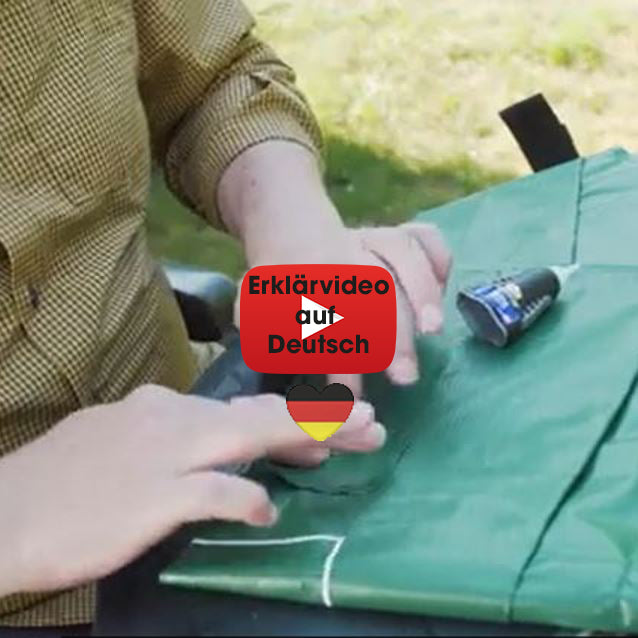
It is not always easy to determine which tree needs how much water. We therefore generally recommend watering a little less rather than too much. Trees are, to a certain extent, accustomed to seasons with their varying amounts of precipitation. It is an important survival factor for a tree to build up a certain level of resistance in order to be able to survive drier periods unscathed. However, due to the changing climate, it is becoming more and more common for dry periods to last longer, for rain to bring with it less water, or for heavy rain, despite large amounts, most of it simply flows away and is therefore inaccessible to the tree roots. Our tree bags serve as watering support to help the trees get through these unnaturally long and unusually dry periods as undamaged as possible.
In many trees, the root system extends over different depths in the ground in order to access any remaining moisture. Once water is available, a tree typically begins storing it in the leaves, branches, trunk, and roots. This is similar to living things. Once these reservoirs are filled up, the trees can survive for a longer period of time without additional water. When a tree's stores have been emptied below a critical threshold, this can first be seen in the leaves, which begin to hang down "powerlessly". If you have the opportunity, this would be a good time to intervene in a supportive manner.
Of course, if it remains dry for a long period of time, it is best to continually support the tree. It makes sense to start with watering every two weeks, even if the probability of rain is still relatively high. If the weather forecast indicates a longer period of heat or drought, we recommend starting weekly drip irrigation immediately and, in extreme conditions, even filling the tree bag twice a week.


Circumference up to: 30 cm (diameter: 9,6 cm) = 1 tree bag
Circumference up to: 60 cm (diameter: 19,2 cm) = 2 tree bag
Circumference up to: 90 cm (diameter: 28,8 cm) = 3 tree bag
Circumference up to: 120 cm (diameter: 38,4 cm) = 4 tree bag
etc.
The baumbad watering bags are designed so that they can be easily connected to each other. Below you will find a video where you can see how this works.
Please note that with the largest possible tree circumference, the bags may not be able to be filled to 100% because the trunk presses against the bag when filled. If this is a problem, it is possible to place the tree bag or bags “freely” next to the desired tree.
"Place individual bags freely on a pole"
and
"Place several bags freely together"
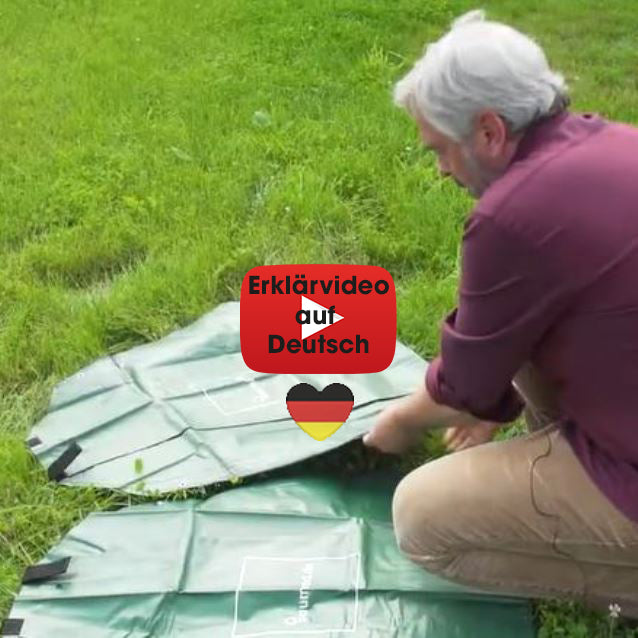

You put our watering bag around the tree like a jacket/robe. This can be done easily, in just a few steps and without a lot of time. A single baumbad tree bag is designed for watering trees with a circumference of up to 30 cm. For larger trees it is possible to combine several tree bags. The simple rule of thumb is that one tree bag is sufficient for up to 30 cm of the circumference. This means:
It may happen that branches, vines or other things are located exactly where the watering bag would normally be placed around the tree. In such a case, the bag can also be placed “freely” next to the tree to be watered. The tree bag is quite stable on its own and only needs a little additional support. It is best to use a wooden or bamboo stick or a metal rod that you stick into the ground next to the bag (if possible without damaging larger tree roots). Now you can mount the tree bag on it in the usual way.
A single watering bag is designed to water trees up to 30cm in circumference.
Only for older trees that have exceeded this size are several baumbad irrigation bags needed. These can be easily connected to each other using the combinable zipper solution.


In comparison to trees, which usually have a free, relatively smooth trunk, hedges and bushes often have branches and branches (or tips and thorns) close to the ground. This means that the irrigation bag cannot be attached directly there.
As already described in your previous customer request, in such a case the bag can also be placed “freely” next to the hedge or shrub to be watered. The tree bag is quite stable on its own and only needs a little additional support. It is best to use a wooden or bamboo stick or a metal rod that you stick into the ground next to the bag (if possible without damaging larger tree roots). Now you can mount the tree bag on it in the usual way.
in addition:
If it is not possible to set it up using the procedure described above, we recommend using the baumbad Premium watering ring (55 L). Since the casting ring is wider, it can usually be installed easily even if there is very little space between the soil and branches.
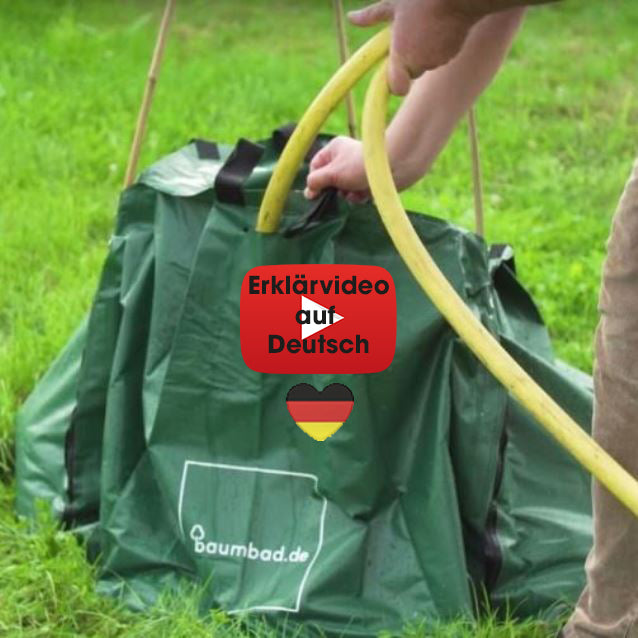

The tree watering bag is largely made of PVC. It has a fairly simple structure, which contributes to its long life expectancy. The tear- and shock-resistant material is additionally supported by a net-like fiber weave.
The lifespan is reduced by:
• Improper handling of the bag (please be sure to follow the instructions)
• Cleaning agents that are too harsh/caustic
• Carelessness when it comes to points or sharp edges on the tree from broken branches and twigs
• Weather influences such as storms, hail, frost or prolonged, intense sunlight (our bags come with UV protection as standard)
• Dogs that repeatedly urinate on the bag over a long period of time
• Improper collisions with lawnmowers or robotic lawnmowers
• Fertilizer additives (depending on chemical composition)
• Winter services that pile up snow or mud on the sides of roads or spread salt in large quantities.
• Rodents, martens or larger wild animals looking for water (usually only if it has been very, very dry for a long period of time)
• Vandalism (just to really sum it all up)
• Algae formation can potentially clog the two openings after a very long period of use.
• Dirty water and other contaminants during filling can also prevent the water from draining properly or even completely block the openings.
Tips for a long service life:
It is best to only use the bags in the phases of the year in which they are needed and then place them dry and cleaned in a dry place so that no algae forms and the bag is protected. If possible, avoid life-limiting circumstances (see above).
It can happen that in times of intense heat, very little rainfall or drought, wild animals can no longer find drinking water. Their well-developed sense of smell tells them that there is water in the tree bags, and out of necessity they nibble on the bags. Small rodents in particular, such as mice, but also martens and foxes, can access the bags.
We have found a solution to prevent animal bites with the watering bag:
Place one or more small bowls on your property and fill them as you fill the bags. This means the animals have easy access to water.
Tip: The bowls should be deep enough in the ground so that there is no edge that protrudes too high so that even small rodents can get to the water to drink.
If it happens that your tree bag has developed holes, you will find instructions in our article “Repairing tree bags” on how you can patch the holes in just a few steps using household utensils. Leftover material patches and additional information on repairing the tree bags can be requested from our customer support.
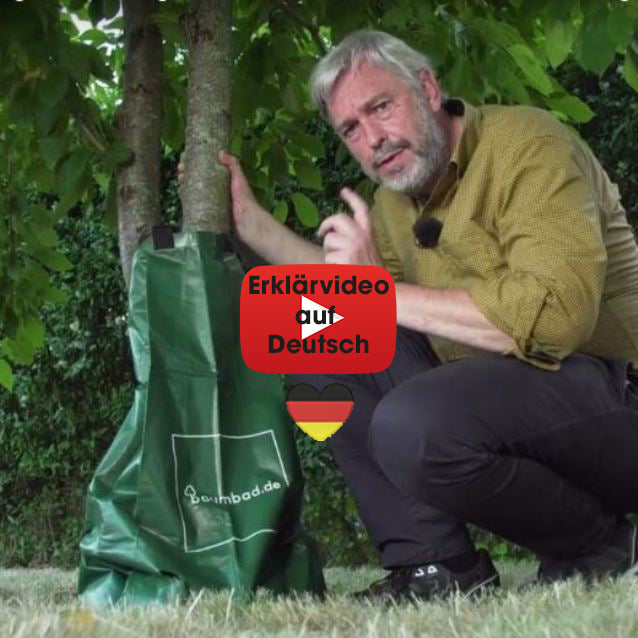

In fact, the number of “green” bags, the so-called irrigation bags, has increased significantly in recent years. And that is important and a good thing.
Due to climate change, the climate has changed continuously in recent years. As a result, on average, it has become warmer almost everywhere in Europe, the amount of precipitation has decreased and the dry periods are noticeably longer. As a result, many plants and trees suffer from an extreme lack of water, especially in the summer months. In many places, the death rate for urban trees has increased significantly, which is also due to the fact that, as the climate situation becomes more extreme, city administrations are increasingly reaching the limits of their capabilities when it comes to providing appropriate care for all trees.
Watering aids like the baumbad watering bag can make a life-sustaining difference. The easy handling and practical design make watering easier for city administrations, tree lovers and those of us who want to get involved in the preservation of city trees.
A process called drip irrigation can save water and a lot of time while keeping the soil around the trees moist for a relatively long period of time. Water continuously seeps into the root area of the trees over several hours through small openings on the underside of the filled tree bags. In this way, the health, resilience and lifespan of our trees can be significantly increased. At the same time, through protection and preservation, we ensure that we can continue to benefit from the natural cooling mechanisms of city trees in the future.
Baumbad already works with many cities and communities throughout Germany. Ask in your city or town whether tree bags are already being used there, whether there is the possibility of tree sponsorships and/or how citizens can get involved in saving the trees.
You are also welcome to contact our tree experts if you have any questions.


The capacity of a baumbad irrigation bag (75 or 100 L) is designed for a tree circumference of up to 30 cm. This corresponds to a trunk diameter of approximately 9,6 cm. If a tree with a larger circumference/diameter is to be watered, we recommend using more watering bags.
Circumference up to: 30 cm (diameter: 9,6 cm) = 1 tree bag
Circumference up to: 60 cm (diameter: 19,2 cm) = 2 tree bag
Circumference up to: 90 cm (diameter: 28,8 cm) = 3 tree bag
Circumference up to: 120 cm (diameter: 38,4 cm) = 4 tree bag
etc.
Every drop is important in filling a tree's water reservoirs. You can do your tree a lot of good with tree watering bags, especially in long dry periods. How much water each tree needs varies from species to species. Large trees usually have a very developed root system that reaches deep into the earth, so that they can often find water deep down that younger trees cannot reach.
Especially when it comes to new plants, it is important to regularly provide them with enough water so that they can develop the appropriate roots. The area under the tree bag, which is constantly kept moist by drip irrigation, is particularly important.
We therefore recommend at least 75 liters (one full bag), but better still 150 liters (two full bags) per watering session. For larger trees (and the use of several tree bags), all tree bags should be filled at least once.


Every tree is a living thing and stores water - in the leaves, branches, trunk and roots. This is similar to living things. When these reservoirs are full, the plants can survive for a longer period of time without additional water. When a tree's storage tanks are emptying, the first sign it usually shows is through the leaves and letting them hang. If you have the opportunity, the tree should be given additional support or watering from this point at the latest.
The roots are the tools with which the trees absorb the water that is essential for survival. How far these roots reach depends, among other things, on the tree species. As a rule of thumb, however, one can say that the main root area can be estimated from the tree crown projected onto the ground. Where there is a water shortage, the roots become longer and the trees move further apart. Most trees have an indispensable helper: mycorrhiza, a network of fungi in the soil. Through this symbiosis, these fungal threads enormously increase the surface area of the roots and thus also their catchment area.
(Source: https://www.lwf.bayern.de/wissenstransfer/forstcastnet/260900/)
Other website on the topic: https://forsterklärt.de/wasserspeicher-wald
Help for your baumbad bag
Quick tips

You still have questions?
Just write to us and someone from our team will get back to you as soon as possible. Alternatively, we have ours Tree Knowledge Guide, with many other topics that might interest you.
Great idea, easy handling and everything from ordering to delivery.
Michael K.


Tree nurseries create life, we at baumbad protect lives.
baumbad, official partner of the Association of German Tree Nurseries.
























